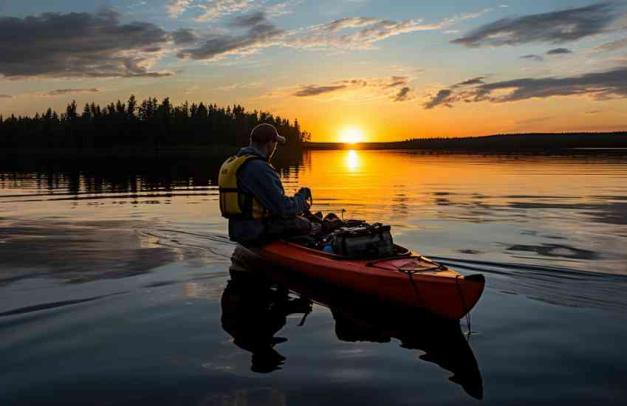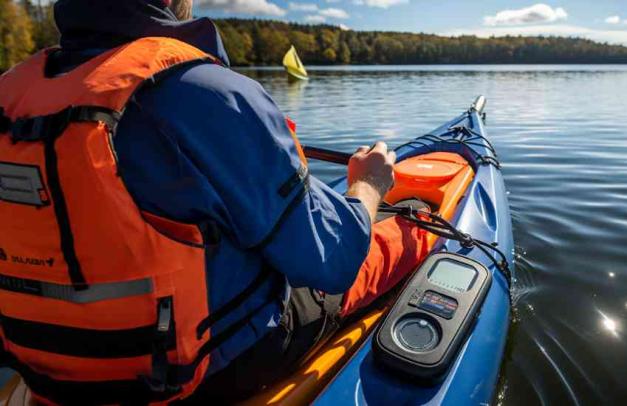2.3 Mastering Safety: Essential Kayak Fishing Precautions on Water

Hi there, welcome to the section on kayak fishing safety measures. In this section, you will learn how to stay safe on the water when you are kayak fishing. You will discover why safety is important for kayak fishing, and what are the potential risks and hazards that you may encounter.
As an experienced angler and writer deeply immersed in the world of kayak fishing, I understand the paramount importance of safety on the water. The thrill of exploring untouched fishing spots across the United States and the joy of reeling in that elusive catch can sometimes overshadow the potential hazards that come with the territory. Drawing from my extensive personal experiences, allow me to guide you through the essential safety measures to ensure your kayak fishing adventures remain enjoyable, secure, and incident-free.
After completing this article, you will learn:
- The significance of safety in kayak fishing and its impact on both personal well-being and the environment.
- The essential safety gear every kayak angler should have, including personal flotation devices, paddles, anchors, and appropriate clothing.
- Important water safety tips, including checking weather conditions, informing someone of your plans, and staying visible to other boaters.
- Strategies for handling wind, waves, and currents effectively to maintain control of your kayak.
- Self-rescue techniques and how to respond to emergencies while on the water.
Basic Water Safety Tips for Kayak Anglers
I vividly recall the early days of my kayak fishing journey along the serene lakes of the Midwest, when my excitement often clouded my judgment regarding basic safety precautions. Learning from my own experiences on waters such as Lake Michigan and Lake Superior, I emphasize the significance of these foundational safety tips:
- Wear a Personal Flotation Device (PFD): It’s not just a piece of equipment; it’s a lifeline. From the tranquil lakes of the Great Plains to the choppy waters of the Atlantic coast, never embark on a kayak fishing trip without a properly fitted PFD. I remember a time when I overlooked this crucial gear, only to realize how it dramatically increased my confidence and peace of mind on the water.
- Inform Someone About Your Plans: Before pushing off into the waters of the Gulf of Mexico or the Pacific Northwest, inform a family member or friend about your intended location, estimated time of return, and any backup plans you may have. This simple step can prove invaluable if unforeseen circumstances arise while exploring the vast waterways of the United States.
- Check Weather Conditions: Mother Nature’s moods can shift swiftly, whether you’re on the peaceful lakes of the Midwest or the challenging coastal waters of New England. Rely on weather forecasts, and pay attention to changes in conditions while you’re out. A sudden thunderstorm on the Great Lakes or strong winds off the Florida Keys can turn a pleasant outing into a potentially dangerous situation. I learned this lesson firsthand during an unexpected squall while exploring the waters of Lake Erie.
Handling Wind, Waves & Currents Effectively
One of the most challenging aspects of kayak fishing in the United States is contending with varying water conditions across different regions. My experiences have taught me the significance of mastering the art of handling wind, waves, and currents on water bodies like the Mississippi River, the Chesapeake Bay, and the Colorado River:
- Wind Awareness: Wind can be both an ally and a foe, whether you’re kayak fishing in the Great Plains or the coastal regions of the Carolinas. On a particularly gusty day, I found myself struggling to maintain control over my kayak in the open waters of the Great Lakes. Implementing a simple technique, I lowered my body to reduce wind resistance and maintain stability, regardless of the region’s water body.
- Riding the Waves: Kayak fishing in the coastal waters of the Atlantic or the Pacific means encountering waves of different sizes. I learned that a perpendicular approach to waves, known as “broaching,” can lead to capsizing. Instead, angle your kayak slightly to minimize the impact and reduce the risk of overturning, whether you’re facing the waves of Cape Cod or the swells of the California coast.
- Respecting Currents: Kayak fishing in rivers like the Mississippi or Colorado introduces the challenge of navigating currents. It’s crucial to understand the direction and strength of the current before setting off, whether you’re exploring the mighty Mississippi or the meandering Colorado. By utilizing a technique called “ferrying,” where you paddle diagonally across the current, I was able to traverse safely without being swept away.
Self-Rescue Techniques and Dealing with Emergencies
While optimism is essential, it’s equally important to be prepared for unexpected emergencies, whether you’re on the waters of the Great Lakes, the Gulf of Mexico, or the Pacific coast. In my journey across the United States, I’ve faced moments of urgency that taught me the value of preparation:
- Mastering Self-Rescue: Capsizing is a possibility, but proper self-rescue techniques can turn a potential disaster into a minor inconvenience. Practicing techniques like the “re-entry and roll” or the “paddle float rescue” can empower you to regain control of your kayak and continue your adventure, whether you’re in the heart of the Ozarks or the Everglades.
- Carry Emergency Equipment: Whether it’s a simple whistle or a waterproof flashlight, having emergency equipment within arm’s reach can be a lifesaver. Personal experiences on water bodies like the Great Lakes and the Gulf of Mexico prompted me to always carry these essentials and to appreciate their significance in critical situations.
- Stay Calm and Signal for Help: In times of distress, panic can escalate an already challenging situation. During one of my more harrowing experiences off the coast of the Carolinas, I realized the importance of staying calm, assessing the situation, and using my signaling devices effectively to attract assistance.
Warp Up
In conclusion, my journey as an avid kayak angler across the diverse waters of the United States has been marked by both triumphant catches and valuable lessons in safety. I’ve navigated the calm lakes of the Midwest, faced turbulent currents of the Mississippi, and explored the vastness of coastal waters. Through this firsthand knowledge of various regions and water bodies, I implore you to prioritize safety above all else in your kayak fishing endeavors across the United States. The tranquility and exhilaration of the open waters await you from the Great Lakes to the Florida Keys, but by applying these insights from my own journey, you’ll not only reel in prized catches but also ensure a safe and memorable adventure.
Remember, the true mastery of kayak fishing lies not only in the techniques but also in the art of ensuring your well-being throughout every moment on the water.
By now, you should have a good idea of how to stay safe on the water when kayak fishing. You are ready to learn more about the paddle strokes that will help you paddle efficiently and maneuver your kayak with precision.
In the next section, you will learn how to master the forward stroke, the sweep stroke, and bracing and sculling. You will also learn some advanced paddling skills for challenging conditions, such as harnessing the wind, navigating rough waters and waves, and maneuvering through tight spaces and obstacles.
Stay tuned!
=============================================
Understanding the Risks
Before diving into the safety measures, it’s crucial to understand the potential dangers associated with kayak fishing:
- Capsizing: Even the most stable fishing kayaks can capsize in rough waters or if improperly balanced.
- Weather Changes: Sudden weather shifts can lead to challenging conditions.
- Water Currents: Strong currents can sweep you off course or into dangerous areas.
- Wildlife Encounters: While rare, encounters with aggressive wildlife can pose threats.
Essential Safety Gear

Every kayak angler should equip themselves with the following safety gear:
- Personal Flotation Devices (PFDs): Always wear a PFD designed for kayak fishing. It should fit snugly and not restrict movement.
- Safety Whistle: A loud whistle can alert nearby boaters or anglers in case of distress.
- Communication Devices: Waterproof VHF radios or fully charged cell phones in waterproof cases can be lifesavers in emergencies.
- Navigation Aids: Always carry a compass and a map of the area. GPS devices can also be beneficial, as mentioned in our article on Utilizing Technology: Fish Finders & GPS Devices for Effective Fishing.
- First Aid Kit: Stocked with essentials like bandages, antiseptics, and medications.
Handling Challenging Water Conditions
Understanding and respecting the water conditions is crucial:
- Wind: Always be aware of the wind direction. If you’re being blown offshore, it’s time to head back.
- Waves: Avoid fishing in areas with large waves unless you’re an experienced angler. Remember the techniques from Navigating Rough Waters & Waves.
- Currents: Always paddle upstream or upwind first, so the return trip is easier.
Self-Rescue Techniques
In the unfortunate event of capsizing:
- Stay Calm: Panic can exacerbate the situation.
- Hold Onto Your Kayak: It’s easier to spot a kayak than a person in the water.
- Re-Entry Techniques: Practice getting back into your kayak from the water in a safe environment before heading out.
- Rolling: A more advanced technique, rolling allows you to right your kayak without exiting it. Consider taking a course or read our article on Mastering Kayak Paddling Techniques.
Emergency Preparedness
Always inform someone of your fishing plans, including:
- Departure and return times.
- Fishing location.
- Emergency contacts.
Additionally, consider carrying emergency signaling devices like flares, especially if fishing in remote areas.
Further Reading:
- Understanding Fish Behavior & Habitats
- Essential Fishing Techniques for Kayak Anglers
- Kayak Fishing in Different Environments
Warp Up
In this section, you have learned about the kayak fishing safety measures that you need to take when you are on the water. You have learned how to follow basic water safety tips, such as checking the weather forecast, wearing a PFD and a whistle, informing someone of your trip plan, and carrying a communication device.
You have also learned how to handle wind, waves, and currents effectively, and how to adjust your paddling and fishing techniques accordingly. Moreover, you have learned how to perform self-rescue techniques and deal with emergencies, such as capsizing, losing your paddle, getting injured, or encountering wildlife.
By now, you should have a good idea of how to stay safe on the water when kayak fishing. You are ready to learn more about the paddle strokes that will help you paddle efficiently and maneuver your kayak with precision.
In the next section, you will learn how to master the forward stroke, the sweep stroke, and bracing and sculling. You will also learn some advanced paddling skills for challenging conditions, such as harnessing the wind, navigating rough waters and waves, and maneuvering through tight spaces and obstacles.
Stay tuned!